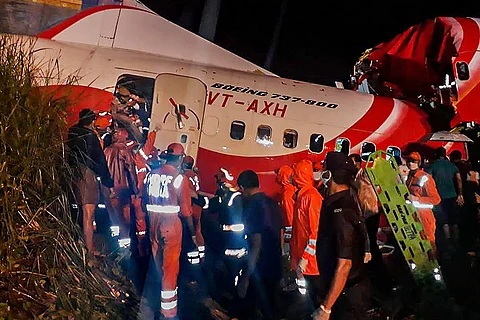

“Excessive rubber deposits” that can prove dangerous for safe landings in heavy rains — this was one of the major findings on the Calicut International Airport that the Directorate General of Civil Aviation (DGCA) had pointed out in its audit report in 2019. Raising “significant safety concerns”, the aviation authority had issued a show-cause notice to the airport, also called Karipur Airport. A year later, on August 7, 2020, the same airport witnessed a horrific plane crash that claimed the lives of 17 passengers on board.
As it was raining on Friday, the Air India Express flight from Dubai, which had 190 passengers on board, skidded on the tabletop runway at Karipur airport and plunged into a 30-feet deep gorge, splitting the aircraft into two pieces by its fuselage. About 110 passengers have been injured, with some in critical condition.
Though it is not clear why the plane crashed, the concerns raised by DGCA have attained significance now. Apart from excessive rubber deposit, which was reducing friction, DGCA had found a five-feet deep steep downward slope “immediately after the apron behind aircraft stand number one”. As per the audit report, parts of the runway at Calicut International Airport had cracks and water stagnation of 1.5 metres near the edge of the runway.
"It is inferred that critical parts of aerodrome required to conduct safe aircraft operations at Calicut International Airport, Calicut, are not being maintained according to the regulatory requirements set out in Civil Aviation Requirement Section 4 (series B Part I). This indicates that the local airport management has not taken timely preventive measures, leading to the above observations," read a part of the order by the DGCA order.
The Airport Authority of India (AAI) then replied that the airport was maintaining runway fiction at a higher value, in accordance with the DGCA guidelines. AAI added that a rubber deposit removal vehicle was being deployed to regularly remove the excess deposits. “We will correct the small patches where the rubber deposits have been reported,” said the aviation body working under the Ministry of Civil Aviation.
According to AAI, although the runway slopes were maintained per standards and the drainage was cleared as part of pre-monsoon preparedness, “due to extensive monsoon, there were some erosion and shallow water stagnation on the side strip”.
On August 4, 2017, a SpiceJet flight had skidded off the runway when landing at Karipur airport. It was raining when the aircraft was trying to make a landing. However, it swerved slightly to the left of the runway, damaging a few guiding lights. All 68 passengers on board were fortunately safe.
It was after a spate of such aviation accidents during the rainy season that the DGCA audited and cracked down on airlines and airports.
Following the DGCA report, in October 2019, the Calicut airport had ordered a five-hour partial closure of the runway, to carry out some maintenance work, including the resurfacing the taxiways and widening the fillet area (the area around turning points on the runway and the taxiway to ensure the plane does not careen off the pavement when turning).
Although the exact details prior to the landing are not known officially yet (the black box is yet to be retrieved), the pilots, who died in the accident on Friday, had circled twice before finally attempting to land. The Air India Express aircraft skidded off the tabletop runaway as it was landing. According to reports, it was moderately raining at the time.
Following the incident on Friday, pilot Anand Mohan Raj took to Twitter to point out that the runway at the Karipur airport has been one of the most challenging runways he has experienced in his aviation career. “The runway guidance lighting system is very poor. Its braking conditions are not monitored regularly,” he said.
1. (2) This is not the right time to point at anyone, but I should say this, Kaipur is one of the most challenging runway I have experienced in my aviation Career. The runway guidance lighting system is very poor, Runway braking conditions is not monitored regularly. pic.twitter.com/DusM8MuTuh
— Anand Mohan Raj (@Anand_Mohan_Raj) August 7, 2020